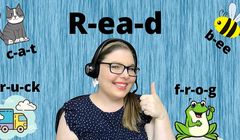Phonemic awareness: What it is, why it’s important, and how to teach it
Phonological awareness is the ability to recognize and work with sound structures in spoken words. Here's how to help your kids learn it. .
When we think about young children becoming readers, we often picture alphabet charts, kids’ books, and the challenging process of “sounding out” words on a page. The English language is complex, and no small feat to master!
But building a strong foundation for literacy success can begin long before children learn to read, with a skill called phonemic awareness.
What is phonemic (and phonological) awareness?
Phonological awareness is the ability to recognize and work with sound structures in spoken words.
People with phonological awareness can notice and produce rhymes (can and man); identify and blend syllables in words (“tea...cher…teacher”); and pinpoint individual sounds in words (“tub …/t/ /u/ /b/”) as well as manipulate them, (“Change the /b/ to a /g/...now the word is tug”).
Phonemic awareness can refer specifically to this last skill: the ability to hear and manipulate individual speech sounds, called phonemes, in spoken words.
For example, a phonemic awareness exercise might ask a child to change a single sound in a word to make a new word (“rug” with a /n/ at the end becomes “run”). Phonemic awareness can also refer to the other skills described above, and is often used interchangeably with phonological awareness. (In this article, we use “phonemic awareness” to refer to skills associated with both phonemic awareness and phonological awareness.)
Young children need strong phonemic awareness to become strong readers. However, phonemic awareness skills can be learned before kids are taught to read or write—no pencil or paper required! They can also be taught alongside literacy instruction.
How learners develop phonemic awareness
Developing phonemic awareness skills is a different process for each child. Some learners begin developing phonemic awareness organically, by singing songs, learning nursery rhymes, and having rhyming books read aloud to them—think “The Itsy Bitsy Spider,” “Hickory Dickory Dock,” and anything by Dr. Seuss.
This is a start, but many learners also require systematic and explicit phonemic awareness instruction to develop the skills they need to get ready for reading.
Five levels of phonemic awareness
To help explain the order in which children develop phonemic awareness, Marilyn Jager Adams created a widely used definition of the term in 1990, focused on specific phonemic awareness skills in five levels:
Ability to hear rhymes (“cat, bat”) and alliteration (repeated initial sounds in words, e.g. “
red rooster.”
Ability to identify similarities and differences in rhyme and alliteration across and between words.
Ability to blend and segment syllables (“af-ter...after," “chicken..chick-en”).
Ability to split a spoken word into phonemes (“map...m-a-p").
Ability to identify and manipulate the sounds in words. E.g. “Say pig. Now change the last sound to a /t/. What do you have now?”
Outschool offers live online classes that allow learners of all ages to practice phonemic awareness skills in a fun environment.
Watch the video here.
Why is phonemic awareness important?
Phonemic awareness is the single best predictor of reading development in young children. It sets them up to master spelling-sound relationships, which means they can more easily connect letters (“A”) with the sounds they make (“/A/” as in apple). This is how literacy instruction begins in elementary school (and sometimes earlier), and leads directly to early decoding: reading written words based on the sounds each letter makes.
Since reading skills and spelling skills go hand in hand, phonemic awareness will help kids become stronger spellers and writers.
When kids enter school with strong phonemic awareness skills, like the ability to hear each sound in the word dog, they have a higher chance of being able to read and write the word dog when literacy instruction begins.
Phonemic awareness at each grade level
How do you know your child is on the right track to developing strong phonemic awareness? Let’s take a look at the ages at which most children master phonemic awareness skills:
Phonemic awareness in preschool
By the beginning of preschool, kids should be enjoying and imitating rhymes and alliteration. Their eyes light up when they hear the title “Fox in Socks,” and they giggle at themselves when saying “yummy yogurt!”
By the end of preschool, children should be able to clap and count syllables (one clap for bus, two claps for taxi), as well as recognize when a word in a group does not rhyme (“hat, mat...mop?”) and when a familiar word has been altered (“Twinkle, twinkle, little...car?”).
Phonemic awareness in kindergarten
At the beginning of kindergarten, kids can produce rhymes, match the first sounds in words, and blend onset (first sound) and rime (word ending) to say a complete word (“c-ap...cap”).
By the end of kindergarten, learners are typically blending sounds in two- or three-phoneme words (“a-t...at,” “h-a-t...hat”) as well as segmenting them (“at...a-t,” “hat...h-a-t”) and deleting syllables and compound word components (elbow without el, raincoat without rain).
Phonemic awareness in 1st grade
By 1st grade, kids can segment longer words, substitute phonemes to make new words (“Change the /p/ sound in map to /n/”), and delete sounds at the beginning and end of simple words (fan with the /f/, book without the /k/).
Phonemic awareness in 2nd grade
By 2nd grade, children use their expanded phonemic awareness to tackle words with blends—two consonants in a row that make two distinct sounds (such as fr in from). They are able to delete the first sound in words that begin with blends (stop without the /s/).
Phonemic awareness in 3rd grade
Once learners are in 3rd grade, they're able to extend this deletion skill to individual phonemes in blends that occur in the medial (middle) and final (end) positions of words: spoon without the /p/, bark without the /r/.
Help your learner develop phonemic awareness with Outschool’s live online classes.
How to teach phonemic awareness
Phonemic awareness instruction is fun for teachers, caregivers, and learners alike. Even structured instruction can be delivered through games, songs, and developmentally appropriate activities that kids love.
Figure out where to start
Determining what skills to teach depends on a child’s age and prior phonemic awareness skills. If a 1st grader is struggling with skills typically learned in preschool, such as clapping syllables, that is the place to begin! Phonemic awareness skills build on each other and cannot be learned in isolation.
Get moving
Incorporating hand and body movements into phonemic awareness activities keeps kids engaged, and this kinesthetic learning component helps them retain knowledge for longer.
Keep it playful
Even the trickiest phonemic awareness activities can be turned into a game. When kids learn joyfully, they feel less anxious and more motivated to keep going.
Teaching phonemic awareness doesn’t need to be a struggle; it can be just as fun as it is valuable.
By understanding and supporting the growth of phonemic awareness skills, we can help kids get a head start on their literacy journey, or give struggling readers and writers the tools they need to catch up.
Editor's note: this blog was originally published on 07/09/2022 and was updated in September 2022.

Similar Reading & Writing articles
Reading & Writing classes


1-on-1 Tutoring






1-on-1 Tutoring

